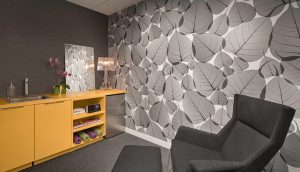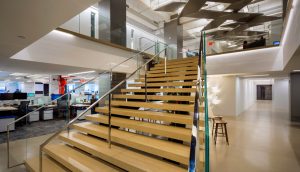BUILDING WELL
Officially launched in 2014 by Delos, and now managed by the International WELL Building Institute, the WELL Building Standard is a leading tool for advancing the health and well-being of building occupants. WELL centers on occupants’ experiences within the built environment—access to daylight, opportunities for movement, and practices and policies that create a holistic approach to wellness.

According to STO Building Group’s director of sustainability, Jennifer Taranto, the WELL Building Standard is grounded in evidence-based medical research and science that centers on how the built environment affects occupant health and wellness. “A great analogy would be if someone went to the faucet to fill up a glass of water, and a murky, hazy liquid came out. They most likely wouldn’t drink it,” she says. “When it comes to ventilation and air filtration, you can’t physically see what’s in the air. You can’t see possible toxins and pollutants. That’s where the research on ventilation and filtration comes into play for the WELL rating system.”
The certification entails on-site testing to measure air and water quality, lighting, thermal comfort, and acoustics. Spot checks in the building are performed for other features like access to healthy food and wellness resources. Once a facility is certified, it must be recertified after three years to ensure everything is still performing as the standard prescribes and to mark improvements.
FULFILLING THE PROMISE
Two STO Building Group offices have already hit the recertification milestone. When BCCI Construction moved their headquarters, they committed to LEED and WELL certification for the health of their employees and the planet. “We knew it could also be an example for clients to showcase the quality we build to, our in-house design services, and our sustainability consulting,” says Kena David, BCCI’s director of sustainability. “We were the first WELL Certified interior in San Francisco and the 31st globally.”
As part of their recertification this year, BCCI’s San Francisco office also earned the WELL Health-Safety Rating, which confirms the measures a tenant has adopted in response to the COVID-19 pandemic to support the health and safety of those who use or visit the space.
 In New York, Structure Tone took the same tack—fitting out their new office to show employees they are valued and to showcase their expertise. The office at 330 West 34th Street—the first WELL Certified space in New York—implemented WELL concepts in a number of ways. For example, in the office’s grab-and-go area, all snacks and food are under 30 grams of sugar, which follows the WELL nourishment concept. To fulfill the light concept, lights are designed to avoid disrupting sleep patterns and to keep occupants energized. The central stairs within the office are also a vital component of the movement concept. The office is beginning its recertification this year.
In New York, Structure Tone took the same tack—fitting out their new office to show employees they are valued and to showcase their expertise. The office at 330 West 34th Street—the first WELL Certified space in New York—implemented WELL concepts in a number of ways. For example, in the office’s grab-and-go area, all snacks and food are under 30 grams of sugar, which follows the WELL nourishment concept. To fulfill the light concept, lights are designed to avoid disrupting sleep patterns and to keep occupants energized. The central stairs within the office are also a vital component of the movement concept. The office is beginning its recertification this year.
STARTING THE JOURNEY
Becoming WELL Certified begins with registration through WELL Online. According to David, it’s best to start as early as possible. “Engage all of the stakeholders, including HR, as well as building maintenance and facilities, whether you are a tenant or owner-occupied,” she says. “Their involvement is critical for mechanical maintenance and cleaning protocols.”
The process also requires documentation and a range of on-site performance tests. Performance Verification consists of a site visit in which a Performance Testing Agent inspects the building to verify documentation and evaluates the WELL concepts. All testing during Performance Verification must be done post-occupancy. Once a facility has completed documentation and passed the Performance Verification, it receives WELL Certification along with an official award letter, plaque, and marketing materials. It can be a long and detailed process but, says Taranto, it represents so much more than a letter and a plaque.
“The most important thing about the WELL Certification is that it is a journey,” she says. “The WELL Building Standard and the WELL Health-Safety Rating really help build the confidence to aid people in returning to the workplace. They have changed the mindset about how we address health and wellness.”
